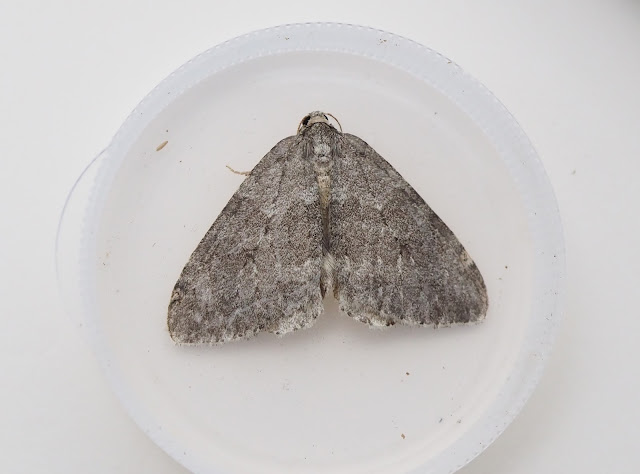Of the four Epirrita moth species I'd only come across Small Autumnal Epirrita filigrammaria before moving to Perthshire. (E. filigrammaria is identifiable by flight time, earlier than E. autumnana, and habitat, it is a moorland moth.) Autumnal Moth Epirrita autumnana has occurred a few times in Orkney, but not on my trap sites. In the last few weeks I've started catching Epirrita moths at my new Perthshire garden.
 |
| A male Epirrita. |
 | |
| Epirrita species, probably also a male. |
In all the identification books there are complex instructions about how to identify these from the wing markings, I don't really understand what they mean as I can't find labelled photographs that make these differences clear. The descriptions all talk about the shape of various lines on the wing around the discal spot. In this case even Leverton and Cubitt is not helpful, although they do suggest that the criteria, once learned are reliable. I need some lessons!
There being no handy teacher I've decided to go down the dissection route. As usual Chris Lewis at his brilliant website makes the dissection criteria very clear. Have a look here - https://britishlepidoptera.weebly.com/operophterini.html Interestingly Chris suggests that the external characters are not reliable.
I know some moth folk are not keen on killing moths to ascertain identification, and would likely just leave these things as Epirrita sp. I like to get stuff to species. To get useful photographs of moths prior to dissection takes some organisation. Indeed, to make sure the whole process is worthwhile takes some quite fastidious work including labelling the moths at an early stage and making sure each photo is directly attributable to a particular individual. Moths are best photographed alive, and I haven't in the (even recent) past always managed to ensure that the live photo can be attributed to a particular dissection. I'm on the case with Epirrita, after a few mis-starts.
Here's one I certainly tracked accurately through.
 |
| Epirrita christyi Pale November Moth, a male, 17/10/2024, live photo. |
 |
| The 8th sternite, the shape is very distinctive. |
 |
| 8th sternite showing the octaval gap measured, = just a tad more than 0.2mm |
Pale November Moth, Epirrita christyi was not the expected outcome, chuffed.
I dissected three more moths from 07/10/2024, unfortunately I did not associate the live photos directly with the specimens, thus only wings of dead specimens are photographed, and they are not especially good images. One moth was a female, the dissection does not differentiate the species reliably.
 |
| A better dissection, showing the valvae clearly. The octavals prove the identification. The photograph of the forewing is not especially useful. |
 |
 |
| Dissection proving November Moth, Epirrita diluta. Note the shape of the 8th sternite, top image, as well as the gap between the octavals. A perhaps more useful forewing image. |
So two Epirrita species are occurring in the garden. I will carry out a few more dissections to try to understand the proportions of each species better. And I will shortly add some labelled photos of live moths to this post.
Off now to sort the trap from last night. But here's a cheeky predator caught on camera trap in our garden yesterday.




2 comments:
I'm glad to see that the Perthshire wildlife is keeping you entertained. And no need to report a Stoat sighting, other than as a mammal record!
Yes, lots to see and record, and dissect! I'll be picking your brains about some places to see Odonata in the spring, just bought the WildGuides book which seems to me to be useful.
Post a Comment